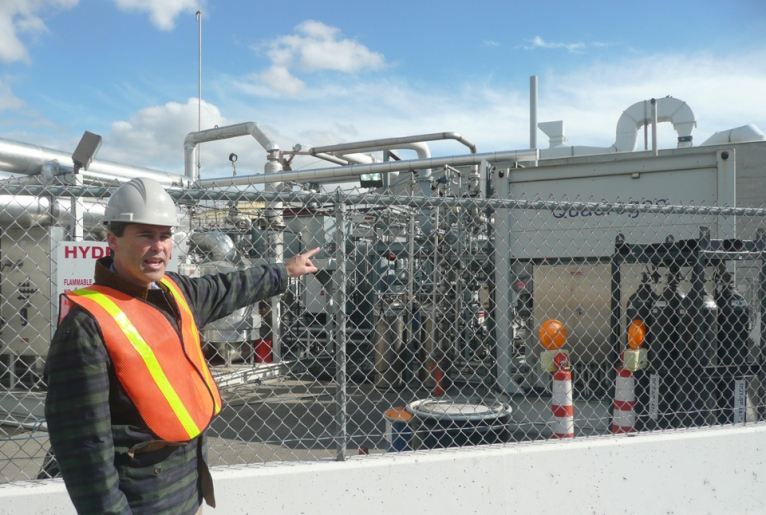“If society’s goals are to reduce carbon from the transportation side, they only have a few options and from our point of view, the fuel cell is the most compelling one.” — Craig Scott, Toyota’s national manager of advanced technologies
Following is the conclusion of the speech by Dr. Ballard at Camden:
“Air pollution takes many adverse forms on earth, but the worst one to my mind is the foul atmosphere that we inflict on inhabitants of the inner city. This has been widely ignored in the environmental debates, where the arguments are directed to cleaning up the upper atmosphere, ozone holes and depletion, and warming trends that could inundate the coast. I acknowledge that the atmospheric conditions are meta-stable and we could tip over the events that would produce catastrophic changes such as shutting down the Gulf Stream. However, the real down home truth is that burning fossil fuels is killing people today and this is not some probabilistic fear about the future. Millions of people throughout the world are being sickened and killed by bad air.”
[Note: These statements are not from a tree hugger, but from a geological engineer and Ph.D]

Smog in Harbin, China, above — and in Los Angeles, California, below

“One does not have to resort to data and statistics to recognize that if 12% of us can cause such havoc to earth’s atmosphere then the other 88% will spell out a doomsday for planet earth if they follow our examples of energy source and use. The developed world has begun to introduce this new energy system, the Hydrogen Economy, which has the potential to truly mitigate or even, one day, virtually eliminate the effects of urban pollution.
The advent of the hydrogen fuel cell has changed the power dynamic because it solves the electricity storage problem. Instead of having to use the electricity immediately, we can transform it into hydrogen, which can be used later in a fuel cell. In other words, with the fuel cell we can now afford to generate hydrogen from electricity during off-peak times, then store the hydrogen and feed it back through a fuel cell to produce electricity at peak need times.
As an aside, if California used its off-peak generating capacity to produce hydrogen to power automobiles, the off-peak capacity, currently unused, would fuel one-third of the 25 million automobiles in the state of California today.
Transforming the transportation sector, this way opens up the doors to other exciting possibilities because the automobile is a natural link to distribute power. One can actually conceptualize the automobile as a stationary power plant on wheels.
Perhaps not the first generation of fuel cell vehicles, but certainly the second or third generation of vehicles will be regenerative fuel cell vehicles and have Vehicle to Grid capability.
[Note: bold and italics are mine for emphasis]
Today’s technology allows us to receive and store hydrogen on board a fuel cell car. It also allows us to generate our own hydrogen on board the car if the car is plugged into the electric grid. A car with this ability to refuel itself is called a “Regenerative Fuel Cell Vehicle”. If we also provide a data and an electronic connection when we plug in to refuel, then the car can be turned on by the building or home to which it is connected. In this way, the car can provide electricity to the grid. The implications of this configuration are enormous when you consider that 85% of the vehicles are parked even during rush hour.
Using California for example, simply because I have data on that piece of real estate, there are approximately 25 million automobiles on the road today in California. If each automobile generates 50 kilowatts, then a single vehicle can generate enough power for 5 to 10 homes. Most automotive manufacturers plan on from 50 to 100-kilowatt engines for their average automobile. One hundred fuel cell vehicles can generate over 5 MW, more than enough to power a 50-story office tower. One million vehicles or 4% of the cars registered in California represents California’s total stationary generating capacity.
One can let their mind run wild with this amount of distributive generating capacity on the roads and byways of the world. It is impossible to avoid the conclusion that most of the power generating capacity of a developed nation will be in its rolling motor vehicle stock. The advent of the fuel cell makes this huge power generating capacity available for daily use.
I have painted a picture with very broad brush strokes and such broad treatment leaves many questions in the minds of thinking people. Today I will address only one of these many questions.
The question goes something like this: “You have said that hydrogen is just a currency, that it is not a primary energy source; you have said that Kyoto is a conservation strategy that you disparage, that the world must increase its use of energy not reduce it; where does all this energy come from that makes all the hydrogen your Hydricity® Economy needs? The answer in a word is NUCLEAR.
If carbon-based energy sources must be set aside, or at least have their emissions sequestered, and I believe they must, then the only remaining large energy source at this stage of our technical development is nuclear. Within the scope of today’s technology, nuclear fission is the only viable, clean source of large quantities of energy. Nuclear generated electric power satisfies the Hydrogen Economy, does not pollute our atmosphere, and mitigates against global warming”.
[Dr. Ballard’s opinion on nuclear energy might have changed, had he still been alive during the devastating earthquake in Japan, but he passed away 3 years before the Fukushima nuclear disaster]
Professor Jack Brouwer, Associate Director and Chief Technology Officer of the National Fuel Cell Research Center, points out the tri-generation facility that uses biogas from Orange County Sanitation District’s wastewater treatment plant to produce hydrogen, heat, and power. | Photo courtesy of the Energy Department. – from https://energy.gov/articles/fueling-next-generation-vehicle-technology
Next: Geoffrey Ballard, Father of the Fuel Cell Industry being honored
Comments are closed here.
